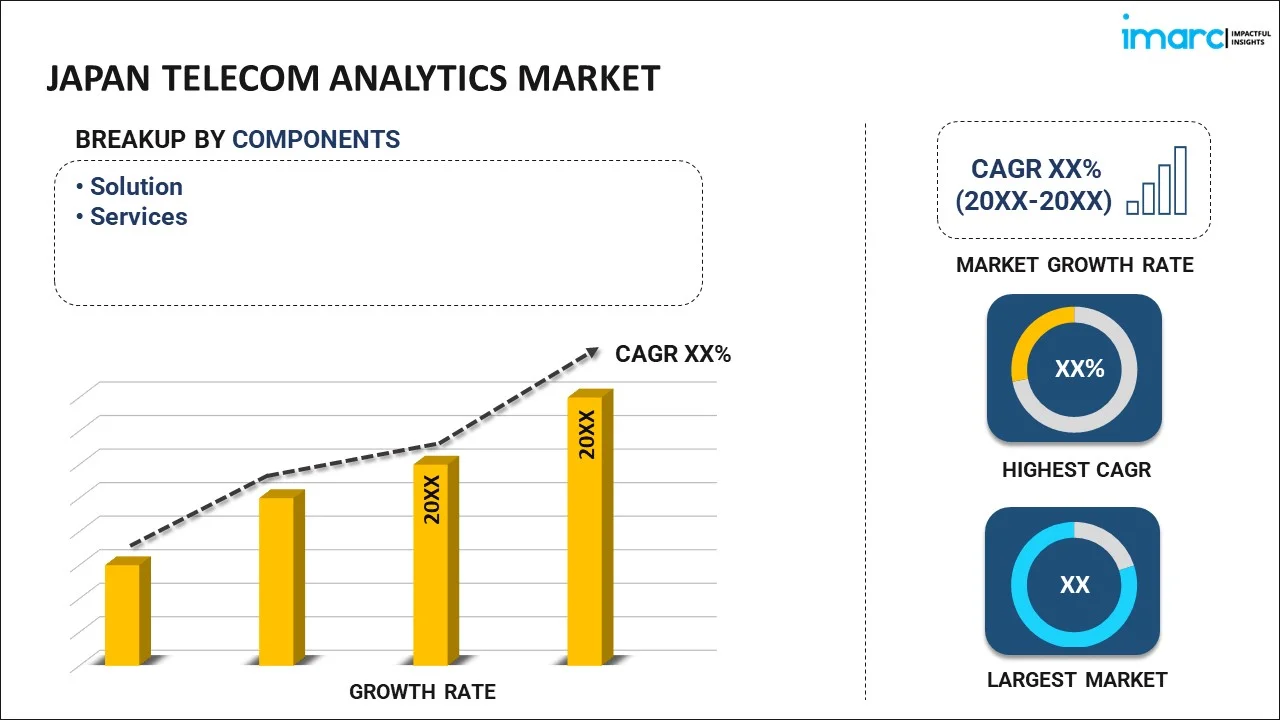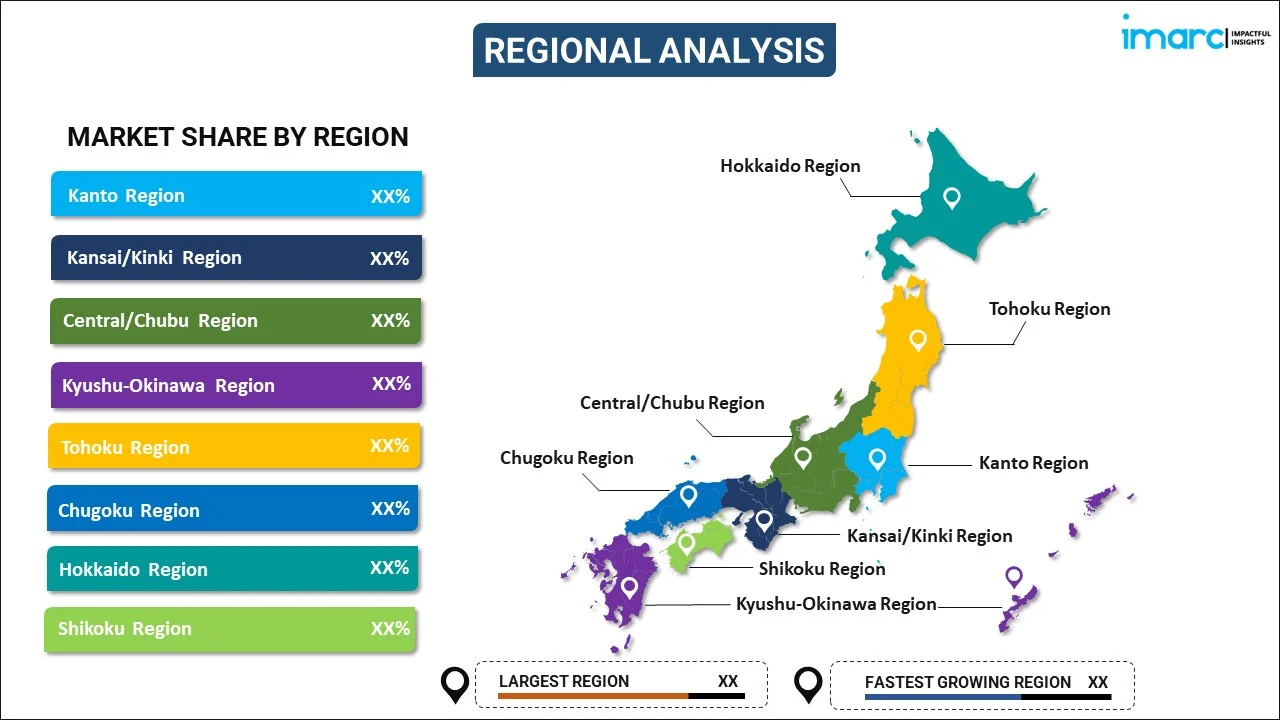
Japan Telecom Analytics Market Report by Component (Solution, Services), Deployment Mode (Cloud-based, On-premises), Organization Size (Large Enterprises, Small and Medium-sized Enterprises), Application (Customer Management, Network Management, Sales and Marketing Management, Risk and Compliance Management, and Others), and Region 2025-2033
Market Overview:
Japan telecom analytics market size reached USD 392.1 Million in 2024. Looking forward, IMARC Group expects the market to reach USD 1,062.4 Million by 2033, exhibiting a growth rate (CAGR) of 11.70% during 2025-2033. The increasing integration of machine learning and artificial intelligence into telecom analytics, which allows for more advanced predictive modeling, anomaly detection, and automation of tasks, is driving the market.
|
Report Attribute
|
Key Statistics
|
|---|---|
|
Base Year
|
2024 |
|
Forecast Years
|
2025-2033
|
|
Historical Years
|
2019-2024
|
| Market Size in 2024 | USD 392.1 Million |
| Market Forecast in 2033 | USD 1,062.4 Million |
| Market Growth Rate (2025-2033) | 11.70% |
Telecom analytics refers to the process of collecting, analyzing, and interpreting data generated within the telecommunications industry to derive valuable insights and make informed business decisions. This field leverages advanced data analytics techniques and tools to examine various aspects of telecommunications operations, including network performance, customer behavior, and market trends. Telecom analytics helps service providers optimize network efficiency, enhance customer experiences, and identify opportunities for revenue growth. It enables them to monitor network traffic, detect and address issues in real time, and predict future demands. Additionally, telecom analytics plays a crucial role in customer relationship management, allowing companies to personalize services, reduce churn, and target marketing efforts effectively. By harnessing the power of big data and machine learning, telecom analytics empowers telecommunications companies to stay competitive in a rapidly evolving industry, offering better services, improving operational efficiency, and ultimately driving profitability while meeting the ever-increasing demands of a connected region.
Japan Telecom Analytics Market Trends:
The telecom analytics market in Japan is experiencing robust growth due to several key drivers. Firstly, the ever-increasing volume of data generated by telecom operators is propelling the demand for advanced analytics solutions. This surge in data is primarily attributed to the proliferation of mobile devices and the exponential growth in data traffic. Consequently, telecom companies are leveraging analytics to gain actionable insights from this data deluge. Moreover, the rising competition in the telecom industry has intensified the need for telecom analytics. Service providers are continually seeking ways to enhance customer satisfaction and reduce churn rates. Analytics plays a pivotal role in achieving these objectives by enabling providers to identify patterns in customer behavior, predict customer preferences, and offer personalized services. Additionally, the evolution of 5G technology is driving the adoption of telecom analytics. Telecom operators are turning to analytics to optimize network performance, allocate resources efficiently, and capitalize on the opportunities presented by 5G. Furthermore, regulatory compliance and security concerns, which are pushing telecom companies to invest in analytics solutions that can help them ensure data privacy and adhere to industry regulations, are expected to drive the market in Japan.
Japan Telecom Analytics Market Segmentation:
IMARC Group provides an analysis of the key trends in each segment of the market, along with forecasts at the country level for 2025-2033. Our report has categorized the market based on component, deployment mode, organization size, and application.
Component Insights:

- Solution
- Services
The report has provided a detailed breakup and analysis of the market based on the component. This includes solution and services.
Deployment Mode Insights:
- Cloud-based
- On-premises
A detailed breakup and analysis of the market based on the deployment mode have also been provided in the report. This includes cloud-based and on-premises.
Organization Size Insights:
- Large Enterprises
- Small and Medium-sized Enterprises
The report has provided a detailed breakup and analysis of the market based on the organization size. This includes large enterprises and small and medium-sized enterprises.
Application Insights:
- Customer Management
- Network Management
- Sales and Marketing Management
- Risk and Compliance Management
- Others
A detailed breakup and analysis of the market based on the application have also been provided in the report. This includes customer management, network management sales and marketing management, risk and compliance management, and others.
Regional Insights:

- Kanto Region
- Kansai/Kinki Region
- Central/ Chubu Region
- Kyushu-Okinawa Region
- Tohoku Region
- Chugoku Region
- Hokkaido Region
- Shikoku Region
The report has also provided a comprehensive analysis of all the major regional markets, which include Kanto Region, Kansai/Kinki Region, Central/ Chubu Region, Kyushu-Okinawa Region, Tohoku Region, Chugoku Region, Hokkaido Region, and Shikoku Region.
Competitive Landscape:
The market research report has also provided a comprehensive analysis of the competitive landscape in the market. Competitive analysis such as market structure, key player positioning, top winning strategies, competitive dashboard, and company evaluation quadrant has been covered in the report. Also, detailed profiles of all major companies have been provided.
Japan Telecom Analytics Market Report Coverage:
| Report Features | Details |
|---|---|
| Base Year of the Analysis | 2024 |
| Historical Period | 2019-2024 |
| Forecast Period | 2025-2033 |
| Units | Million USD |
| Scope of the Report | Exploration of Historical and Forecast Trends, Industry Catalysts and Challenges, Segment-Wise Historical and Predictive Market Assessment:
|
| Components Covered | Solution, Services |
| Deployment Modes Covered | Cloud-based, On-premises |
| Organization Sizes Covered | Large Enterprises, Small and Medium-sized Enterprises |
| Applications Covered | Customer Management, Network Management, Sales and Marketing Management, Risk and Compliance Management, Others |
| Regions Covered | Kanto Region, Kansai/Kinki Region, Central/ Chubu Region, Kyushu-Okinawa Region, Tohoku Region, Chugoku Region, Hokkaido Region, Shikoku Region |
| Customization Scope | 10% Free Customization |
| Post-Sale Analyst Support | 10-12 Weeks |
| Delivery Format | PDF and Excel through Email (We can also provide the editable version of the report in PPT/Word format on special request) |
Key Questions Answered in This Report:
- How has the Japan telecom analytics market performed so far and how will it perform in the coming years?
- What has been the impact of COVID-19 on the Japan telecom analytics market?
- What is the breakup of the Japan telecom analytics market on the basis of component?
- What is the breakup of the Japan telecom analytics market on the basis of deployment mode?
- What is the breakup of the Japan telecom analytics market on the basis of organization size?
- What is the breakup of the Japan telecom analytics market on the basis of application?
- What are the various stages in the value chain of the Japan telecom analytics market?
- What are the key driving factors and challenges in the Japan telecom analytics?
- What is the structure of the Japan telecom analytics market and who are the key players?
- What is the degree of competition in the Japan telecom analytics market?
Key Benefits for Stakeholders:
- IMARC’s industry report offers a comprehensive quantitative analysis of various market segments, historical and current market trends, market forecasts, and dynamics of the Japan telecom analytics market from 2019-2033.
- The research report provides the latest information on the market drivers, challenges, and opportunities in the Japan telecom analytics market.
- Porter's five forces analysis assist stakeholders in assessing the impact of new entrants, competitive rivalry, supplier power, buyer power, and the threat of substitution. It helps stakeholders to analyze the level of competition within the Japan telecom analytics industry and its attractiveness.
- Competitive landscape allows stakeholders to understand their competitive environment and provides an insight into the current positions of key players in the market.
Need more help?
- Speak to our experienced analysts for insights on the current market scenarios.
- Include additional segments and countries to customize the report as per your requirement.
- Gain an unparalleled competitive advantage in your domain by understanding how to utilize the report and positively impacting your operations and revenue.
- For further assistance, please connect with our analysts.
 Inquire Before Buying
Inquire Before Buying
 Speak to an Analyst
Speak to an Analyst
 Request Brochure
Request Brochure
 Request Customization
Request Customization




.webp)




.webp)












